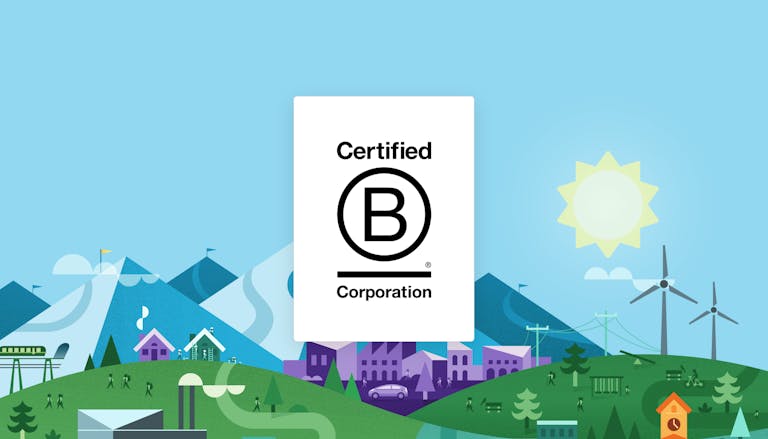
“How sustainable is my company?” A first look at the B Impact Assessment

Lisa
June 30, 2025
It's easy to say, but what does that mean? How do you measure how "good" or "effective" your business is? This is exactly where the B Impact Assessment (BIA) stepped in. For us, it was the starting point toward B Corp certification, as well as a real change of perspective.
Different ways to measure impact
There are plenty of ways to measure corporate impact. Some companies use the Sustainable Development Goals (SDGs) of the United Nations as a framework. Others rely on ESG (Environmental, Social, Governance) criteria or develop their own impact logic. The B Impact Assessment from B Lab offers a structured and comprehensive approach for companies seeking a holistic view of their social and environmental responsibility.
What the BIA does and why it pays off
The BIA is a comprehensive online questionnaire that companies can use to analyze their impact in key areas. With the introduction of the new standards in April 2025, the previous five categories were expanded and replaced by seven Impact Topics:
- Purpose & Stakeholder Governance
- Climate Action
- Human Rights
- Fair Work
- Environmental Stewardship & Circularity
- Impact Management
- Equity, Diversity & Inclusion
These new standards require companies to meet minimum requirements in each area rather than achieving an overall score of at least 80 points. This ensures that companies cannot excel in one area while performing poorly in others.

An overview of the seven new Impact Topics (since April 2025)
Unlike other approaches to impact measurement, the BIA has special features. While ESG criteria are often capital market-oriented and primarily serve as a basis for investor decision-making, the BIA focuses more on a company's internal development. The SDGs, on the other hand, offer a global framework for orientation, but they often remain vague at the company level. Impact logics, which are more frequently used in project work, are helpful but require significant in-house development and methodological expertise.
The BIA is free and open to companies of all sizes and industries. It asks specific, sometimes uncomfortable, questions:
- How inclusive is your corporate culture?
- How transparent is your salary structure?
- How can you measure your ecological footprint?
After just a short time, you realize that this is not just a feel-good tool, but rather a real compass for achieving entrepreneurial impact. It challenges you with uncomfortable questions and reveals areas where clarity, structure, or measurable goals are lacking. This may be challenging, but that is precisely why it is valuable. It highlights blind spots, provides direction, and helps set new priorities.
Our experience at Peerigon
We went through the BIA as part of our initial B Corp certification and again as part of the recertification process. It is an integral part of the entire process, and it is intensive and challenging each time.
What has helped us in particular is that: The BIA uncovers gaps and makes existing strengths visible. For example:
- Our flexible working models and chances to contribute to the team.
- Our open, participatory approach to decision-making.
- Our ongoing commitment to climate protection and social projects.
Yes, there are always issues. The BIA has shown us areas in which we can improve: documentation, impact measurement, and setting long-term goals.
How long does it take to complete the B Impact Assessment?
The time required to complete the BIA varies depending on the company's size, complexity, and existing documentation. For small to medium-sized companies, it typically takes between one and three months, depending on how accessible the necessary data is and how well processes have been documented internally.
The first certification, in particular, can be very time-consuming. Due to interruptions and parallel projects, it took us around a year and a half to complete the first run, and several colleagues were involved. For the current recertification, however, the effort has been less: we have invested around 50 hours to complete it, including the verification phase.
Although this effort may seem overwhelming at first, it offers a real opportunity to structurally develop your company and implement sustainable processes. The best part is that certification isn't necessary. The BIA can be used as a valuable tool, independent of the official certification process, as a framework for reflection, and for continuously improving your corporate impact.

B Corp Certification Process
Who is the BIA suitable for?
Honestly, the BIA is for everyone who is serious about corporate responsibility. Whether you are a start-up, SME, or established company, the BIA can be a valuable introduction or catalyst. This is true even if you are not aiming for B Corp certification.
All it takes is time and a willingness to take a closer look.
Four practical tips for getting started with B Impact Assessment
1. realism beats wishful thinking: Answers should be based on what has actually been implemented, not on plans or intentions. Only measures that have already been implemented and proven count.
2. documentation is key: Many questions require written evidence. Those who document guidelines and processes not only score points in the BIA but also create clarity internally.
3.Sustainability is teamwork: The BIA affects the entire company, from management to employees, not just a single role. Having clear responsibilities and a simple, well-functioning exchange of knowledge helps tremendously.
4. It's a tool, not a test: The BIA is not a test that you have to "pass"; it's a tool to help you learn. It shows where you stand and helps you recognize where you want to go.
Conclusion: A tool that sharpens your view of the future
The B Impact Assessment is a framework for reflection, not just an evaluation tool. It helps you identify your strengths, pinpoint areas for improvement, and define concrete next steps. For us, it was an important building block on our path to greater responsibility and impact, and we recommend it to any organization looking to rethink business.
🤖 Statement about usage of AI in this article: This article was written by humans (thanks for the feedback Philipp and Meaku!), including the title, concepts, code samples. However we used AI for research and to enhance the style of writing.
Corporate Social Responsibility
B Corp Zertifizierung
B Impact Assessment
Nachhaliges Wirtschaften
Impact Tools
Read also

Nick, 11/12/2025
Green Coding: A Developer's Guide to Sustainable Software
Green Coding
Green IT
Carbon Footprint
Sustainability

Michael, 10/20/2025
Optimizing Vercel for Lower Carbon Emissions: A Developer's Guide
Vercel
Next.js
Green Software
Sustainable Development
Carbon Emissions
Developer Guide

Julia, 10/14/2025
A beginner's guide to the terminal
Terminal
Guide
Beginner
Development